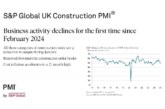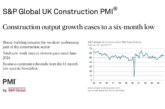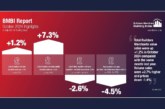
The CPA main scenario for construction output in 2020 is a 14.5% fall as the construction industry shows promising signs of recovery from the coronavirus pandemic.
Demand for new private housing and private housing repair, maintenance and improvement (rm&i), as well as strong growth in the infrastructure sector, are expected to support recovery for the industry towards the end of this year and into the next following historic falls in output during lockdown. The prospects, however, of both a deterioration in labour market conditions along with a potential ‘No Deal’ Brexit deal at the end of December mean that the upcoming winter will be decisive for how far such a recovery can be sustained.
The Construction Products Association’s (CPA) Autumn Scenarios, published today, continue to expect a tick-shaped economic recovery as the most likely outcome, with output for construction rising by 13.5% in 2021 from the sharpest fall on record in 2020. The easing of lockdown measures over the summer was accompanied by a rush to meet pent-up demand, particularly in private housing and refurbishment work that couldn’t take place as sites were closed. With social distancing integrated on construction sites, productivity was also able to pick up.
The CPA points out that the housing market is being given a boost from pent-up demand coming through and transactions being brought forward by both the stamp duty holiday and the end of the first phase of Help to Buy in March 2021. Equally, private housing rm&i has benefited from home working brought on by the pandemic. With more disposable income as a result of spending less on travel and hospitality, many households are choosing to spend it on ‘safe’ options such as home improvements. Some caution remains from 2021 Q2, however, with the end of the stamp duty holiday and uncertainty in the employment market possibly reducing demand.
Along with private housing, the CPA expects the infrastructure sector to be critical for growth. With output not falling as sharply this year as in other sectors due to larger sites making social distancing easier, next year’s growth will capture the start of main works on HS2, plus ongoing work on major projects such as offshore wind, Thames Tideway and Hinkley Point C. Only airports within the infrastructure sector are expected to see a decline in activity over the next few years, given sharp declines in airline passenger numbers as a result of the pandemic.
Commenting on the Autumn Scenarios, the CPA’s Economics Director, Noble Francis, said: “The easing of the social distancing restrictions in summer led to a sharp recovery in certain sectors of the construction industry – most notably, in the form of increased demand for private housing and private housing rm&i where growth is currently strong. The government’s commitment to infrastructure delivery, as outlined in the National Infrastructure and Construction Procurement Pipeline for 2020/21, is also a promising sign of growth.
“But, uncertainty continues to loom for the commercial sector. If working from home becomes more ingrained in society, footfall in city and town centres will decline leading to a lack of demand for office and retail space. Equally, a critical winter lies ahead for the wider economy. The key risks to the construction industry remain a potential second national lockdown and a ‘No Deal’ Brexit, which are illustrated in the CPA’s other scenario. Either would lead to a second dip in the UK economy and construction output.
“A free trade deal agreed in principle with the EU, with the details determined over time, would at least give some degree of confidence for what is still a fragile economic recovery. In addition, construction recovery so far has been highly reliant on government either directly through spending in infrastructure or indirectly through policy stimulus to boost housing. Government has an extra responsibility, therefore, to deliver on its announcements and ensure construction recovery does not stall in the next 12 months. We certainly aren’t out of the woods yet.”









